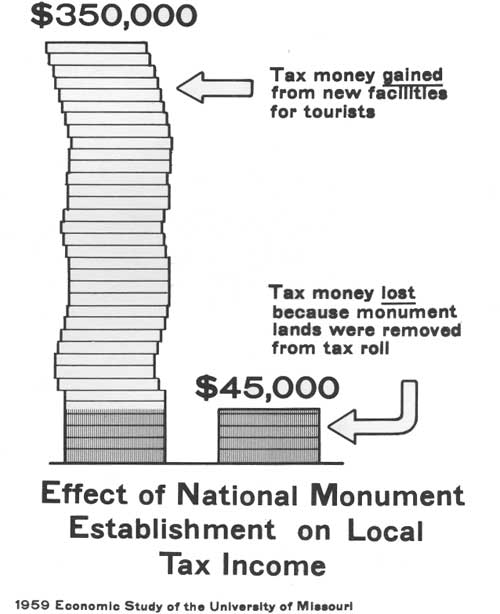|
OZARK
Ozark Rivers National Monument A Proposal |

|
ECONOMIC EFFECT
The Current-Eleven Point River Country was settled largely in the third and fourth decades of the 19th Century, mostly by people of English ancestry from the mountain regions of Kentucky, Tennessee, Virginia, and North Carolina. They hunted, fished, and raised corn on small tracts of land in the river valleys, and were undisturbed by the main stream of westward migration which bypassed them. During the Civil War, the people were divided in their loyalties. As a result, their settlements were plundered by guerilla bands and by Union and Confederate forces alike.
After the eastern forests were depleted, lumber interests turned to the Ozarks for new and untouched sources of timber. Railroads were built, great lumber mills established and the exploitation of the last frontier in Missouri began. Lumbering flourished from 1875 to 1915, but by 1919 the land had been so cut over that the Ozark lumber industry died and with it, the economy it supported.
Some people then turned to cutting immature trees and farming the hill lands. Neither of these provided more than mere subsistence. Hill farming was unsuccessful because the topsoil soon eroded away after cultivation, leaving gravelly, droughty soil low in nutrients. Even now, farming is difficult on the bottomlands because mechanical farming equipment just can't be used efficiently in the narrow valleys. As farming becomes more mechanized, the farmers in the Current and Eleven Point River valleys find themselves in an increasingly poor competitive position. In 1955, the cash income of 40 percent of farm families in this area was less than $1,000. Even so, agriculture is still the major source of income for Carter, Oregon, Ripley, and Shannon Counties. Data from the 1950 census show that the median family income in this area is only 42 percent of the average for the State of Missouri.
Forests cover approximately three-fourths of the land within Carter, Oregon, Ripley, and Shannon Counties. Their quality is somewhat less in the Ozarks than in the remainder of the state primarily because of the lower productivity of land. Since the establishment of Clark National Forest in 1934 and the State Conservation Commission's Division of Forestry in 1938, gradual rehabilitation of the forest has been occurring. As a result of new practices, annual growth rate in the Clark National Forest has increased from 36 board feet per acre in 1946 to 93 in 1956. Cutting timber on a sustained yield basis from large land tracts may be profitable; however, the income farmers get from timber and timber products is negligible. Less than 3 percent of the total farm income in the area is derived from the sale of forest products.
Up to the present time, very little industry has moved into this area. In June 1959, Carter, Oregon, Ripley, and Shannon Counties, containing 97 percent of the Monument area, had a total of 27 firms employing 585 persons. Employment opportunities in industry appear limited at the present time.
The population peak for this area occurred in 1910 during the lumber boom. Since then, there has been a steady decline except during the depression years when some unemployed city workers returned to their former homes in the Ozarks. The population now is only about 70 percent of what it was 50 years ago. Also relatively few people of working age live here, having gone to places where employment opportunities are better.
The National Park Service secured the services of the University of Missouri to make an economic study of the Current—Eleven Point River Country and to determine the effect of the proposed National Monument upon the local and regional economies. This study was based upon certain premises such as size of area, number of visitors, and time required for development.
Major conclusions resulting from the University study are that five years after establishment of proposed Monument, assuming adequate development, over 800,000 additional visitors would be attracted to the region annually and they would spend $5,500,000; that new motels, hotels, and other tourist facilities costing $33,000,000 would be required to accommodate the increased number of visitors; and that $10,000,000 of assessed value would be added to the county tax rolls assuming current assessments on urban property in the area are about 30 percent of actual value.
Current assessed valuation of lands within the proposed Monument is estimated at $1,300,000. The conclusions of the University, therefore, indicate the tax base for the counties involved would gain approximately $8,700,000, and the annual tax return might increase by $300,000 if the National Monument were established.
These estimates appear reasonable after reviewing information developed by the University of Wyoming for the Jackson Hole Chamber of Commerce. It reveals that Teton County depends in large part upon tourists who began visiting in great numbers after Grand Teton National Park was enlarged. Acquisition of lands for the National Park did not destroy the tax base, in fact additional tourist facilities more than made up for the loss of park lands from the tax rolls.
Lands proposed for inclusion in the Monument total approximately 113,000 acres. Of these, 84 per cent or about 95,400 acres are in private ownership. Appraisal sampling indicates a considerable variation in cost. Considerations such as severance values add to the difficulty of making close estimates at this stage. In round figures, a total in the neighborhood of $5,500,000 might be anticipated.


| <<< Previous | <<< Contents>>> | Next >>> |
proposal/sec7.htm
Last Updated: 04-Nov-2009